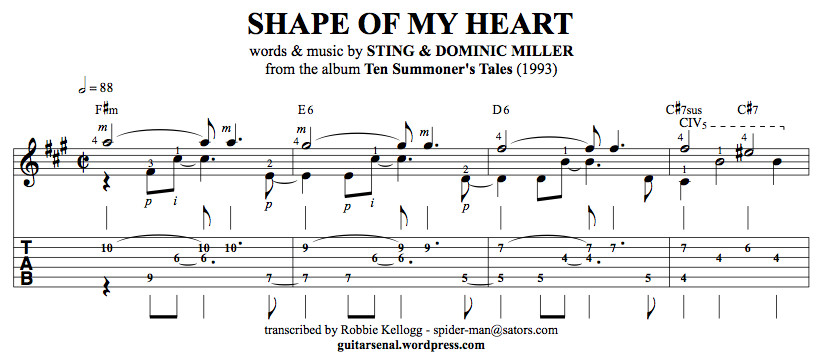“Shape of My Heart” by Sting, featuring the distinctive guitar work of Dominic Miller, remains an iconic song for its melancholic melody and intricate fingerstyle arrangement. For guitar players, mastering Miller’s part is both a rewarding challenge and a lesson in musicality and technique. This guide delves into the beauty of this piece, offering insights and resources to help you learn to play “Shape of My Heart” on guitar, focusing on accurate tabs and Miller’s unique approach.
Decoding Dominic Miller’s Guitar Genius in “Shape of My Heart”
Dominic Miller’s guitar part in “Shape of My Heart” isn’t just accompaniment; it’s an integral voice that shapes the song’s emotional landscape. Analyzing his playing reveals key aspects of his style that go beyond simply hitting the right notes. He masterfully blends technical proficiency with a deep understanding of tone and musical space.
Beyond the Notes: Understanding Miller’s Approach
The original author of the source article humorously noted some of Miller’s apparent preferences and dislikes: a seeming aversion to open strings and the high E-string, a fondness for complex fingerings, and a clear obsession with “good tone.” While lighthearted, these observations point to crucial elements of Miller’s style. He prioritizes tone and voicing above ease of playing, often opting for richer, darker sounds achieved by playing melodies on the G and B strings rather than the thinner E string.
 Dominic Miller's fingerstyle technique for Shape of My Heart
Dominic Miller's fingerstyle technique for Shape of My Heart
Miller’s approach is characterized by:
- Emphasis on Tone: As highlighted, Miller’s pursuit of “good tone” is paramount. This manifests in his string choices and chord voicings, contributing to the song’s warm and intimate sonic texture.
- Triadic Voicings: He frequently employs three-note chord voicings (triads), creating a sophisticated harmonic foundation that is both subtle and supportive.
- Intentional Simplicity: Despite the technical demands, there’s a remarkable simplicity in the arrangement. Miller understands the power of “less-is-more,” trusting the bass and other instruments to fill out the sonic space, allowing his guitar part to breathe and resonate.
The Importance of String Choice: G and B Strings
One of the most insightful points from the original article is the discussion of string choice for the melody. Many guitarists might instinctively play the melody on the high E-string, but Miller’s recorded version utilizes the G-string, and in his current performances, he often favors the B-string. This seemingly small detail makes a significant difference in the song’s overall sound.
Playing the melody on the G or B string imparts a warmer, darker, and richer tone compared to the brighter, thinner sound of the E-string. This choice is crucial to the song’s melancholic and introspective mood. As Miller himself explains, the E-string version is the “simplest way but not the best sounding.”
Less is More: Simplicity and Groove
Another critical aspect of Miller’s genius is his “Big Picture” view of the guitar’s role within the ensemble. He doesn’t overplay or clutter the arrangement. Instead, he focuses on syncopated simplicity, creating a groove that complements the other instruments and vocals. He intentionally omits the bass note at the beginning of measures, trusting the bass player to anchor the low end. This restraint and awareness of musical space are hallmarks of masterful accompaniment.
Mastering “Shape of My Heart” on Guitar: Tabs and Techniques
Learning to play “Shape of My Heart” accurately requires attention to detail, particularly in fingerpicking technique and chord voicings. Here’s how to approach mastering this beautiful piece:
Fingerpicking Technique and Accuracy
The original article points out a common mistake: employing a “busy” fingerpicking pattern akin to Travis picking. While Travis picking is a valuable technique, it’s not suited for “Shape of My Heart.” Miller’s fingerpicking is characterized by its syncopated simplicity. Focus on a steady and deliberate approach, emphasizing the melody notes and allowing space between the bass notes. Listen closely to the original recording to internalize the rhythmic feel.
Chord Voicings and Stretches
“Shape of My Heart” is an excellent study in three-note chord voicings (triads). The chord shapes often require stretches, which, as the original author notes, can be beneficial for developing left-hand dexterity and correcting bad habits. Pay close attention to the fingerings suggested in accurate guitar tabs. Understanding the chord construction – knowing the notes within each chord and their scale degrees – will deepen your understanding and improve your overall musicianship.
Learning from Miller’s Insights and Available Tabs
Dominic Miller is known for being generous with his knowledge, sharing insights into his techniques and fingerings on his website and in interviews. The original article highlights Miller’s own explanations of different fingering approaches for “Shape of My Heart,” including his preference for the B-string melody in contemporary performances and the original G-string melody from the recording. He even provides detailed fingering for a specific D6 chord that had puzzled many players.
 Dominic Miller performing Shape of My Heart
Dominic Miller performing Shape of My Heart
To truly learn this song, utilize accurate guitar tabs that reflect Miller’s intended voicings and string choices. The original article conveniently provides links to tabs for both G-string and B-string melody versions:
Get Your “Shape of My Heart” Guitar Tabs:
- Shape of My Heart – Full Score (Melody on the B-string)
- Shape of My Heart – Full Score (Melody on the G-string)
These tabs offer invaluable resources for learning the song as Miller intended. Experiment with both versions to understand the nuances of melody placement and chord voicings.
Conclusion: Embrace the Beauty and Challenge
“Shape of My Heart” is more than just a popular song; it’s a masterclass in guitar arrangement and technique. By studying Dominic Miller’s approach and utilizing accurate guitar tabs, you can unlock the beauty and depth of this piece. Learning this song will not only expand your repertoire but also deepen your understanding of fingerstyle guitar, chord voicings, and the art of musical accompaniment. Download the tabs, practice diligently, and enjoy the journey of mastering this iconic guitar part.
